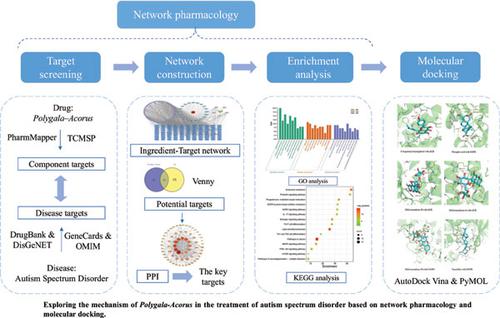当前位置:
X-MOL 学术
›
Curr. Comput.-Aided Drug Des.
›
论文详情
Our official English website, www.x-mol.net, welcomes your
feedback! (Note: you will need to create a separate account there.)
Mechanism of Polygala-Acorus in Treating Autism Spectrum Disorder Based on Network Pharmacology and Molecular Docking
Current Computer-Aided Drug Design ( IF 1.5 ) Pub Date : 2023-11-20 , DOI: 10.2174/0115734099266308231108112058 Haozhi Chen 1 , Changlin Zhou 1 , Wen Li 1 , Yaoyao Bian 1, 2
Current Computer-Aided Drug Design ( IF 1.5 ) Pub Date : 2023-11-20 , DOI: 10.2174/0115734099266308231108112058 Haozhi Chen 1 , Changlin Zhou 1 , Wen Li 1 , Yaoyao Bian 1, 2
Affiliation

|
Background: Recent epidemic survey data have revealed a globally increasing prevalence of autism spectrum disorders (ASDs). Currently, while Western medicine mostly uses a combination of comprehensive intervention and rehabilitative treatment, patient outcomes remain unsatisfactory. Polygala-Acorus, used as a pair drug, positively affects the brain and kidneys, and can improve intelligence, wisdom, and awareness; however, the underlying mechanism of action is unclear. Objectives: We performed network pharmacology analysis of the mechanism of Polygala–Acorus in treating ASD and its potential therapeutic effects to provide a scientific basis for the pharmaceutical’s clinical application. Methods: The chemical compositions and targets corresponding to Polygala–Acorus were obtained using the Traditional Chinese Medicine Systematic Pharmacology Database and Analysis Platform, Chemical Source Website, and PharmMapper database. Disease targets in ASD were screened using the DisGeNET, DrugBank, and GeneCards databases. Gene Ontology functional analysis and metabolic pathway analysis (Kyoto Encyclopedia of Genes and Genomes) were performed using the Metascape database and validated via molecular docking using AutoDock Vina and PyMOL software. Results: Molecular docking analysis showed that the key active components of Polygala- Acorus interacted with the following key targets: EGFR, SRC, MAPK1, and ALB. Thus, the key active components of Polygala-Acorus (sibiricaxanthone A, sibiricaxanthone B tenuifolin, polygalic acid, cycloartenol, and 8-isopentenyl-kaempferol) have been found to bind to EGFR, SRC, MAPK1, and ALB. Conclusion: This study has preliminarily revealed the active ingredients and underlying mechanism of Polygala-Acorus in the treatment of ASD, and our predictions need to be proven by further experimentation.
中文翻译:

基于网络药理学和分子对接的 Polygala-Acorus 治疗孤独症谱系障碍的机制
背景: 最近的流行病调查数据显示,全球自闭症谱系障碍 (ASD) 的患病率不断上升。目前,虽然西医大多采用综合干预和康复治疗相结合的方式,但患者的治疗效果仍然不尽如人意。Polygala-Acorus 用作配对药物,对大脑和肾脏有积极影响,可以提高智力、智慧和意识;然而,潜在的作用机制尚不清楚。目的: 我们对 Polygala-Acorus 治疗 ASD 的机制及其潜在的治疗效果进行了网络药理学分析,为该药剂的临床应用提供科学依据。方法: 使用中医系统药理学数据库和分析平台、化学来源网站和 PharmMapper 数据库获得 Polygala-Acorus 对应的化学成分和靶点。使用 DisGeNET、DrugBank 和 GeneCards 数据库筛选 ASD 中的疾病靶标。使用 Metascape 数据库进行基因本体功能分析和代谢途径分析 (京都基因和基因组百科全书),并使用 AutoDock Vina 和 PyMOL 软件通过分子对接进行验证。结果: 分子对接分析显示,Polygala-Acorus 的关键活性成分与以下关键靶点相互作用:EGFR 、 SRC 、 MAPK1 和 ALB。因此,已发现 Polygala-Acorus 的关键活性成分(sibiricaxanthone A、sibiricaxanthone B tenuifolin、polygalic acid、cycloartenol 和 8-异戊烯基-山奈酚)与 EGFR、SRC、MAPK1 和 ALB 结合。 结论: 本研究初步揭示了 Polygala-Acorus 治疗 ASD 的活性成分和潜在机制,我们的预测需要进一步的实验来证明。
更新日期:2023-11-20
中文翻译:

基于网络药理学和分子对接的 Polygala-Acorus 治疗孤独症谱系障碍的机制
背景: 最近的流行病调查数据显示,全球自闭症谱系障碍 (ASD) 的患病率不断上升。目前,虽然西医大多采用综合干预和康复治疗相结合的方式,但患者的治疗效果仍然不尽如人意。Polygala-Acorus 用作配对药物,对大脑和肾脏有积极影响,可以提高智力、智慧和意识;然而,潜在的作用机制尚不清楚。目的: 我们对 Polygala-Acorus 治疗 ASD 的机制及其潜在的治疗效果进行了网络药理学分析,为该药剂的临床应用提供科学依据。方法: 使用中医系统药理学数据库和分析平台、化学来源网站和 PharmMapper 数据库获得 Polygala-Acorus 对应的化学成分和靶点。使用 DisGeNET、DrugBank 和 GeneCards 数据库筛选 ASD 中的疾病靶标。使用 Metascape 数据库进行基因本体功能分析和代谢途径分析 (京都基因和基因组百科全书),并使用 AutoDock Vina 和 PyMOL 软件通过分子对接进行验证。结果: 分子对接分析显示,Polygala-Acorus 的关键活性成分与以下关键靶点相互作用:EGFR 、 SRC 、 MAPK1 和 ALB。因此,已发现 Polygala-Acorus 的关键活性成分(sibiricaxanthone A、sibiricaxanthone B tenuifolin、polygalic acid、cycloartenol 和 8-异戊烯基-山奈酚)与 EGFR、SRC、MAPK1 和 ALB 结合。 结论: 本研究初步揭示了 Polygala-Acorus 治疗 ASD 的活性成分和潜在机制,我们的预测需要进一步的实验来证明。































 京公网安备 11010802027423号
京公网安备 11010802027423号